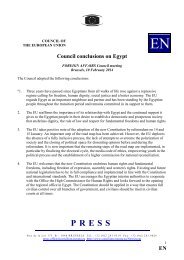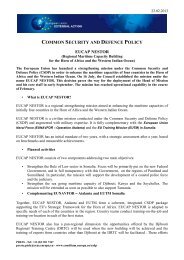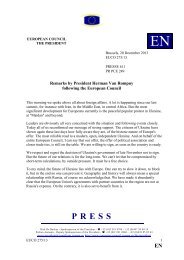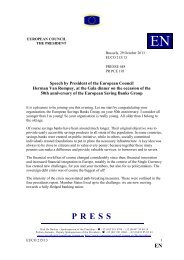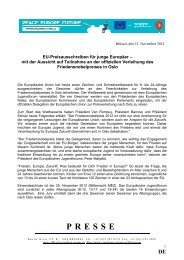14508/09 ADD 1 PL/vk 1 DG G COUNCIL OF THE ... - Europa
14508/09 ADD 1 PL/vk 1 DG G COUNCIL OF THE ... - Europa
14508/09 ADD 1 PL/vk 1 DG G COUNCIL OF THE ... - Europa
You also want an ePaper? Increase the reach of your titles
YUMPU automatically turns print PDFs into web optimized ePapers that Google loves.
Latvia had the greatest proportion of men and women with experience of unmet demands (figure<br />
4.3.3). In a majority of countries the proportion of men and women with unmet demands varies<br />
between one and ten percent. In those Member States both men’s and women’s demands are met to<br />
the greatest extent in Slovenia,. In figure 4.3.4 the differences between women and men are further<br />
illustrated. In more than half of the countries the proportion of women is larger than the proportion<br />
of men with unmet demands; in seven countries the proportions are approximately the same, and in<br />
those four countries with the highest proportions of women with unmet demands the differences<br />
between the sexes are also the greatest. In Luxembourg the gap between the sexes is as large as in<br />
Poland – but reversed.<br />
When the reasons for unmet demands are introduced into the statistics mentioned above, an<br />
interesting pattern emerges. Among those who have forced reasons for their unmet demands, the<br />
proportion of women is greater than the proportion of men in almost all countries; but less than one<br />
percent for more than half the countries (figure 4.3.5) Among those who chose themselves not to<br />
have their demands met, the proportion of men was larger than the proportion of women in a<br />
majority of countries (figure 4.3.6). Here, too, the differences were mostly small.<br />
In all EU countries which presented data on the causes of death in 2006, a greater proportion of<br />
women than men died from cardio-vascular diseases (figure 4.3.7). Bulgaria was the country<br />
reporting the highest proportions of women and men dying from cardio-vascular disease (71 % of<br />
the women and 62 % of the men). The lowest proportions were found in France (31 % of the<br />
women and 26 % of the men). The differences between the proportions of women and men who die<br />
from cardio-vascular diseases are shown in figure 4.3.8. Among the five countries with the highest<br />
proportions of women dying from cardio-vascular diseases (figure 4.3.7), four had the largest<br />
differences between women and men (figure 4.3.8).<br />
4.3.4 Trends emphasised in Member States' reporting to the UNECE<br />
In many EU countries preventive programmes addressing women’s health issues have been set up,<br />
such as screening for breast cancer, cervical cancer and for HIV infection among pregnant women.<br />
In a few countries, the vaccination of girls against HPV virus infections and future cervical cancer<br />
has been launched. Attitudes to contraception and legal abortion vary between countries, as do the<br />
laws and the investment of society in terms of allocating resources.<br />
<strong>14508</strong>/<strong>09</strong> <strong>ADD</strong> 1 <strong>PL</strong>/<strong>vk</strong> 67<br />
ANNEX <strong>DG</strong> G EN







